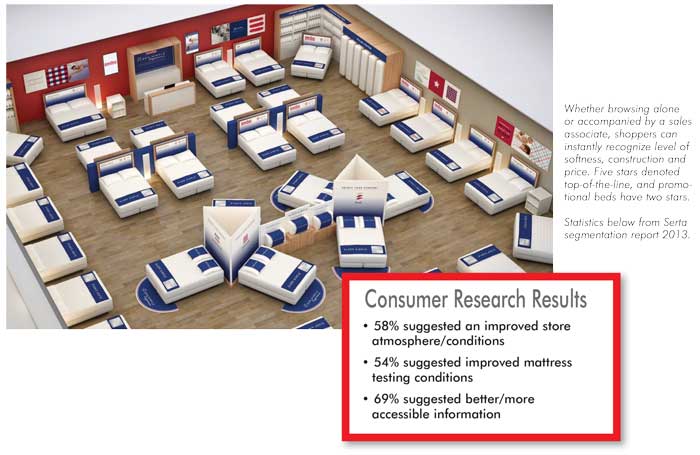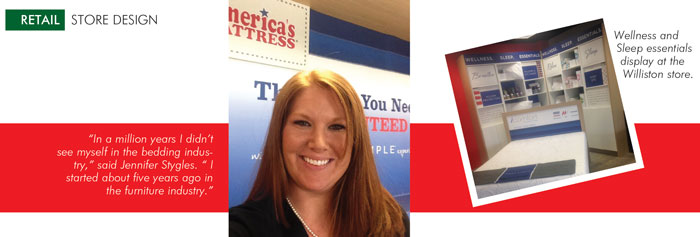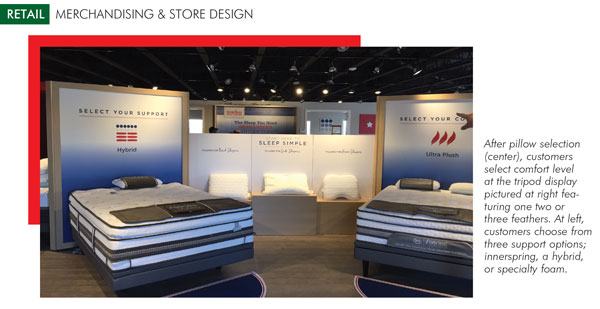by Melody Doering
"Simplicity,” wrote Leonardo da Vinci, “is the ultimate sophistication."
Keeping it simple, however, in the world of bedding retail is difficult. Nevertheless, Serta’s Retail Concepts Group has created a sophisticated retail solution with their Sleep Simple concept for America’s Mattress stores.
America’s Mattress was started about 20 years ago as a test partnership with a local retailer. The test proved a success and there are now nearly 200 owners with more than 400 stores across the country. Licensed retailers, who agree to sell exclusively Serta mattresses, are provided with an America’s Mattress development territory uniquely for them.
Within the past year, America’s Mattress teamed with Martin Roberts, of Martin Roberts Design, to reconfigure both their stores’ interior plans, as well as their sales process. According to Mike Juoni, Senior Manager of the Retail Concepts Group at Serta Simmons Bedding, the Sleep Simple concept sought to fulfill three primary goals: Improve the overall experience for the customer - giving customers a recognizably different experience; Differentiate with a unique presentation in the marketplace - creating separation from competitors, avoiding the same look and feel from every other store; Provide a proprietary, documented, and repeatable experience – an updated design and experience that is scalable, opening the doors to new candidates.”
The result was an elegant retail solution that achieves these goals by tying the customer experience to store design. It’s a model that bedding retailers selling multiple bedding lines may benefit from studying.
The overall design, fixtures, top-of-bed, wall art, and cabinetry provide a welcoming feel for each retail customer. The sales process, specifically created to flow with the design, allows both the retail sales associate and the customer to follow a simple and comfortable process.

Currently there are ten stores, operating under the new format. With pending stores and conversions of some existing stores, America’s Mattress plans to have roughly 30 more Sleep Simple stores in 2016. Each retailer carries a selection of Serta mattresses and motion bases, plus a selection of PureCare sheets and other premium sleep related accessories along with a selection of Serta and iComfort pillows and protectors.
Furniture World spoke with Martin Roberts about the Sleep Simple design process, and with Jennifer Stygles, the owner of the America’s Mattress Store in Williston, VT, whose customers put Sleep Simple to the test every day.
The Design Challenge
No stranger to designing for mattress retailers, Martin has an immediate grasp of the challenge for consumers who simply want to get a good night’s sleep. “The average mattress store 10 years ago was probably 1,500 to 2,500 square feet. Today, retailers are looking at bigger stores with 50 or 75 beds on the floor. That makes the process of buying a lot more complicated.
“We began by coming up with a brand name and brand positioning, which was all about trying to create something that was simple for the retailer to sell, simple for the customer to buy, and simple for the customer to make a decision about comfort, specification and price.”
Professional buyers, in furniture and bedding stores, are subject to many of the same stresses as consumers. Martin observed, “Retailers go into showrooms at High Point, for instance, and they are faced with a sea of products and manufacturers encouraging them to buy certain things, perhaps even providing incentives. But they may ignore the most important thing, which is how the customer buys. By making that a simple process that customers can identify with, they can increase their sales dramatically in the same amount of square footage. It’s all about the under-pinnings of the process behind the product, not just having more product.”
Jennifer Stygles’ America’s Mattress store opened November, 2015, and she is already seeing how her customers are benefiting from the Sleep Simple concept. “Our customers have already been doing their research either online or by shopping around for a day or two. I just had a customer in here that had gone to four different mattress shops in one day. She came back and said “Oh my goodness, this place is the easiest place to buy.”
Store As A Selling Machine
Curiously, keeping it simple turns out to be hard work. Serta wanted a truck to arrive at a new retailer’s store and for everything to be unloaded, assembled, and ready for business in a few day’s time. “That was kind of the brief,” Martin reflected, “It isn’t just about making the store design look pretty. It’s first of all about understanding the selling process in mattress stores, and about coming up with a formula that would make it better for the consumer, as well as more productive for the retailer. And of course, eventually more productive for the brand. Being an industrial designer by background, I tend to think of stores as being selling machines. In other words, it is important to create something that sells more merchandise or there’s no point in doing it. The function of a store is to sell more.”
“So Sleep Simple became a brand name,” Martin explained. “We developed that idea to be unique, a bit like the ThinkPad or Apple products. We tried to keep the idea of Sleep Simple, so that the idea is simply about sleep.
“The other thing we wanted to do,” he continued, “was create some Americana inspired graphics at the point of sale, because it’s called America’s Mattress. We didn’t want huge flags all over the place that would distract from the promotional graphics, making it difficult for the customer to get to the information that they need. We created what we call a ‘Tommy Hilfiger-inspired graphics program,’ which has some elements of stars and stripes, red, white, and blue. Graphic panels on the walls give a hint about the American heritage of the collection. These panels are stretched graphics over aluminum frames, very light and easy to ship. They can be changed to keep the store fresh and interesting.”

Jennifer is an enthusiastic proponent for the Sleep Simple concept. “The best thing about the store is the layout. It’s not just a plain-vanilla box with 50 mattresses in it, lined up like soldiers. The store is oriented in a way that there’s a flow to it; from the flooring to the paint to the artwork.
“The back wall, being bright red, really sticks out. We have the traditional Serta logos along with phrases like ‘American quality’ and ‘American comfort’ and ‘The sleep you need guaranteed.’ You know, you kind of just feel at home here.”
The Williston Store
Jennifer’s “simple” store in Williston, VT (Burlington area), is a meticulously crafted outlet, where almost every eventuality has been considered. Martin adds, “We’ve minimized the number of graphic signs and messaging inside the retail space so a customer can focus on their decision of what they want to buy.
“We’ve trained the installation staff how to cross-beam the lights, so the lights aren’t in the eyes of customers when they’re lying on the bed. We’ve put low-level lights to light the beds horizontally so that you see all the textures on mattress tops: all the silk threads that are used in the quilting and the detailing. Halo or spot lighting lights the beds from above.
“It can all arrive flat in the truck and be assembled onsite. From cash registers to shelving systems that hold candles and scented pillows. Every single thing is in that truck, so it literally comes in and the team assembles it all. They pack up their trash and drive away.” The amount of downtime for the retailer is minimized so they can be in business very quickly without having months of waiting for construction to be done and components to arrive and things to be shipped from abroad. All of that is taken care of at a very reasonable cost.
Getting Into The Business
Jennifer spoke about getting into furniture retail and opening her new store. “In a million years I didn’t see myself in the bedding industry. I started about five years ago in the furniture industry. After I had my first child I went back to work for part-time as a general bookkeeper for Brown Furniture in West Lebanon, NH. I worked for Philip Desmond, who’s been in the furniture business for over 30 years. He showed me the ropes; how everything worked, how to keep inventory low, and gross margin high. Philip took me under his wing and mentored me. Then an opportunity arose to become a partner in a bedding store.
“I’m a numbers person and I could see that it doesn’t cost a lot of money to open a mattress store or keep high levels of inventory. So that’s how I got into the mattress business, and then it just took off from there. I really like the support America’s Mattress gives, from website support to frequent conversations with Gordon Hecht, the regional manager about ideas, promotions, advertising and getting people to the door. With the help of my sales rep, Peter O’Brien, we really nailed down the best sellers at all price points.”
Sales Process
Besides the carefully designed physical layout of Sleep Simple stores, a comprehensive sales process was formulated covering greetings, demonstrations, and confirmations; whether the shopper wants full-service, or prefers to browse on their own. Either way, the store’s design streamlines the sales process by eliminating unnecessary steps.
After greeting customers and asking qualifying questions about their sleeping position and problems they may be experiencing with their current mattress, Jennifer fits customers who prefer full service for a pillow, after first fitting it with a disposable covering. Pillow in hand, she directs them to the right, where a tripod gives information on comfort levels. “Once you fit them with a pillow,” she explained, “they use it to sample different mattresses. We seem to have success with Pure Care or Dr. Greene pillows. People really love those pillows.”
Next, customers are directed to displays having vertical graphics at eye height that can be used to sort beds into firm, plush and ultra-plush categories. Once a shopper picks a particular softness, that already eliminates two-thirds of what’s available inside the store to look at.
Jennifer went into more detail: “We have two different tripod displays. The one to the right says ‘You select your comfort,’ where we determine if the customer likes a firm, plush, or ultra-plush mattress.”
She points out the feather icons and helps customers decide what level of softness they would like to try. Jennifer and her sales team guide customers through the logical choice progression. Unless a customer states a preference for a specific type of support, the first option is softness, followed by construction. “We ask the customer questions as they are selecting the comfort level. Maybe they have a firm bed now and they’re saying that their back is killing them because of the way they’re sleeping.”
The next step is to direct customers to the tripod that explains the various support options: innerspring, a hybrid of innerspring and memory foam, or specialty foam. “Once the customer has selected the support method, more unnecessary choices are removed, leaving a manageable number of mattresses to consider. Customers are actually very open with us,” Jennifer reported. “They’ll come up and say, ‘I just went to the Tempur-Pedic store, or I usually sleep on a Stearns and Foster or a Sealy.’ Being mattress experts, we have an idea of what those mattresses are, and what’s in our store that compares to them.”
The method of qualification highlights three or four mattresses for the customer to try. Star icons on the headboard signage indicate price levels. Jennifer went on, “If I’m a person that likes a plush mattress and I am not looking to spend a ton of money, then I want to be looking for two feathers and three stars. The customer is thinking, ‘I know which mattresses are in my budget and I know what’s in my comfort level, so I don’t have to try out every mattress.’

“So we narrow it down to about three or four different mattresses,” Jennifer continued, “and the customer will let you know, ‘Well, what do you have for half that price?’ And what’s great about our store is that we have the Value Center with the same icon system of price range, comfort, and support. So the Sleep Simple store truly hits every single customer, whether they’re on a minimum budget or a maximum budget. And within the first 15 minutes of their stay, they’re going to realize which mattress is for them.
“Self-service shoppers can use recognizable icons for comfort, support, and value on each mattress. They can spot their perfect choice based on their need for a restful bed and their budget. “The headboards are all magnetic strips where the information is laid out,” Jennifer explained. “One feather is for firm, two are for plush, and three is for ultra-plush. Then the star rating shows the price range. Five stars, obviously, are the top-of-the-line beds. And it goes down to two stars, which is the lower end.”
Closing And Attachments
When the customer has chosen a mattress, they are led to the closing station. Throughout the sales process, Jennifer has been talking about the warranty and guarantee. “What I always try to stress with customers is if you don’t like your mattress within the 120 nights, we can exchange it for you. However, it needs to be protected. So I roll it into my presentation how effective these mattress protectors are, using terminology that they can understand. I talk about how much fluid your body loses at night, and that things are shedding off your body. We have displays that show them what happens to a mattress over time. At some point the customer comes to understand that we want them to protect their investment, just like having car insurance.
“You never wait until the end to bring up the attachments,” she added. “People usually say no if you wait until the last minute. I mention it probably three times during each sale. The customer’s already thinking toward the end, ‘Oh man, I already spent $2,000, I don’t want to spend any more money.’ So if you mention it throughout the time they’re here, then it’s built into their brain that they need to protect their investment.
“Sheets are a little bit different. They are hard to incorporate into a sale. When you’re in an area like Williston where there is a Bed Bath & Beyond, and a Wal-Mart, there are plenty of other options out there. We are looking to develop a three-price-range package deal. So, Instead of saying to somebody, ‘Here’s sheets for $300,’ we can say, ‘Here’s a package that includes delivery, the pillows, sheets, mattress protectors.’ It sounds better when you’re bundling things together. It’s like when they first came out with bundling the TV, phone, and internet. You’re going to be saving money.”
When asked about how she presents adjustable bases, she replied, “It’s kind of a second thought when people are trying out the different beds and they ask, ‘What kind of base is this?’ It’s like back in the day when you thought having a reverse camera in your car was a luxury. Now pretty much every car comes with one. A lot of people are watching TV in bed, and their neck is killing them because they are propped up on a mound of pillows. We get them thinking, ‘Oh wow, for an extra 700 bucks I can get an adjustable base?’ It is something that people are growing accustomed to. About one out of every 7 or 8 customers choose an adjustable base.”
Stores With Multiple Brands
One of the most powerful effects of creating a store concept where the sales process flows from a store’s design is that it becomes consistent and repeatable, to which Jennifer can attest. “We like to get to know the customer and just make the experience as easy as possible. We get a lot of referrals from family members.”
A similar approach to store design is possible for retailers carrying multiple mattress brands, and worth considering. But to do so, retailers must focus first on creating an organized system that’s built into their store’s design. To make it work, that system must be considered before store buyers choose products to inventory and every time sales associates take their next up.
Martin concluded, “The point about Simple Sleep is that we’ve refined the system to work well, in addition to creating the thought process that directs the selling system. It’s not just pretty design, it’s something that really works.”
Furniture World is the oldest, continuously published trade publication in the United States. It is published for the benefit of furniture retail executives. Print circulation of 20,000 is directed primarily to furniture retailers in the US and Canada. In 1970, the magazine established and endowed the Bernice Bienenstock Furniture Library (www.furniturelibrary.com) in High Point, NC, now a public foundation containing more than 5,000 books on furniture and design dating from 1620. For more information contact editor@furninfo.com.